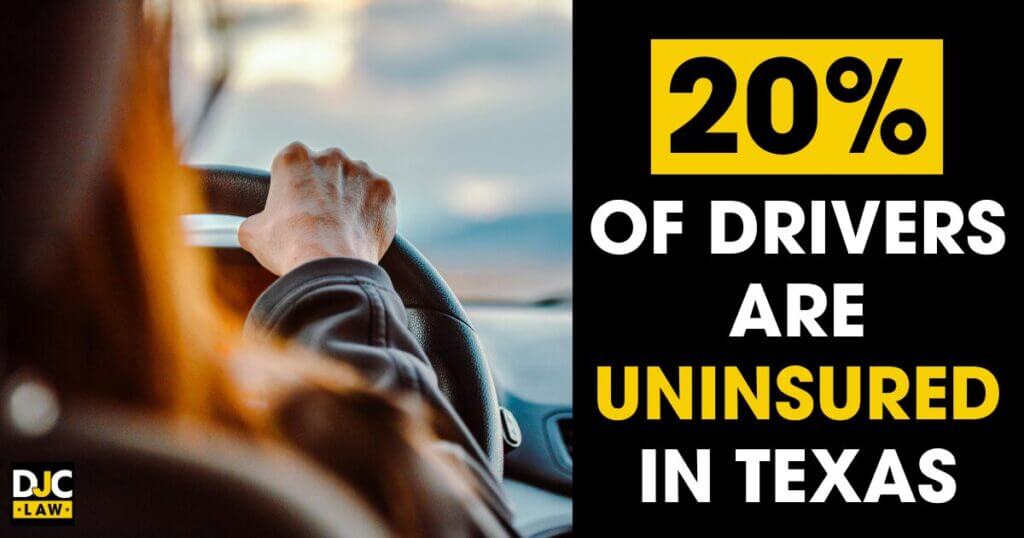Auto insurance is something most of us take for granted because it’s something we all know we have to have if we want to drive without getting into trouble with the law. However, it might surprise you that the Insurance Information Institute reports that around 14% of drivers are uninsured nationwide.
As terrible as that sounds, the situation is even worse in Texas, with the Texas Department of Motor Vehicles reporting that as many as 20% of drivers are uninsured. It’s a figure that adds up to millions of drivers you encounter each day.
And it’s not just a problem for them. It’s a problem for everybody if you get into a car accident with someone who has no insurance. Here’s what you must know about driving without insurance in Texas and what happens if someone hits you without a valid policy. If you've been involved in an accident with an uninsured driver, consulting an experienced Austin car accident lawyer can help protect your rights and secure compensation.

Key Takeaways
- Texas requires all drivers to have the necessary insurance coverage by law if they’re operating motor vehicles on public roads.
- In Texas, drivers must have minimum liability insurance, translating to $30,000 for bodily injury per accident victim, $60,000 per accident, and $25,000 to cover property damage. This is known as the 30/60/25 model.
- Penalties for driving without insurance include fines, license suspension, SR-22 filing requirements, vehicle impoundment, and increased auto insurance premiums. Jail time is a rarity, but it is possible if you’re also involved in an accident resulting in serious injury or death.
- Causing an accident while being uninsured means you’ve got no protection against lawsuits filed against you. Losing a civil lawsuit means assuming financial liability, which could see your wages being garnished and your assets seized.
- The best defense against uninsured drivers is uninsured/underinsured motorist coverage, which covers your losses if a driver hits you without a valid insurance policy.
- Contact a qualified and experienced personal injury lawyer if you’ve been hit by an uninsured driver or you’ve been wrongly ticketed for not having insurance.
Understanding Texas Insurance Laws
Texas requires all drivers to have a valid auto insurance policy when operating a motor vehicle on public roads. This law aims to ensure that drivers can financially cover the losses they inflict on others when they’re at fault.
The Texas Department of Insurance formed TexasSure after the passing of Senate Bill 1670 to provide a database that can quickly verify insurance coverage for any registered vehicle on the roads as part of improving public safety.
Since Texas is an at-fault state, it’s the obligation of the driver responsible for the accident to cover the losses of accident victims. Without insurance, victims risk being left out of pocket, which could result in financial ruin.
Minimum Requirements for Auto Insurance in Texas
Texas law requires drivers to have a minimum amount of liability coverage to be road legal. The requirements are known as the 30/60/25 model, which translates to $30,000 for bodily injury for each victim, $60,000 per accident, and $25,000 for property damage.
Liability-only coverage will only pay for the damages you cause to others. It won’t provide any recompense for your own injuries. Another issue is that these policy limits are relatively small, meaning they won’t cover the damages of serious accidents.
According to KVIA, Texas is the 19th most dangerous state for fatal accidents. Holding minimum coverage means you’ll be woefully underinsured, making you vulnerable to lawsuits leveled against you personally, thus putting your personal assets at risk.
Importance of Car Insurance in Texas
Holding car insurance in Texas isn’t just about the law but about protecting you and others from the consequences of the severe injuries and losses resulting from catastrophic accidents.
Driving without insurance is illegal, and you’ll face penalties, including fines, vehicle impoundment, and license suspension. But aside from that, the other issues are:
- Insurance pays for your bills.
- Insurance allows for claims to be settled relatively quickly.
- Insurance protects assets like your home, car, and bank accounts from personal injury lawsuits filed against you.
Even if you’re uninterested in the legal aspect, auto insurance is the best defense you’ve got for protecting your home and family.
Consequences of Driving Uninsured in Texas
Driving uninsured in Texas is against the law, and you’ll face significant penalties if you’re pulled over and can’t produce evidence of a valid policy. Penalties range from fines and SR-22 requirements to potential vehicle impoundment and license suspension. Jail time is also a possibility for subsequent offenses.
Sound tough? Penalties have been strengthened over the years to protect law-abiding drivers and encourage compliance, with TexasSure estimating that the uninsured cost drivers an extra $900 per year on their premiums.
Initial Penalties for First-Time Offenders
Got stopped for no insurance for the first time? It’s a Class C misdemeanor, which is the lowest class of charge.
A first offense carries penalties including:
- Fines starting at $175 and rising to $350.
- Annual surcharge of $250 per year for the next three years.
- Requirement to file an SR-22 form for at least two years.
You may also face the potential for your car being impounded, which comes with its own set of fees.
Escalating Penalties for Repeat Offenders
Repeat offenders don’t receive the same penalties. Instead, Texas uses an escalating punishment system for repeat offenders. How many times you’ve been caught driving uninsured and under what circumstances will determine what the charges are.
Here are the escalating penalties you can expect:
- Fines from $350 to $1,000.
- Ongoing annual surcharge.
- Vehicle impoundment for up to 180 days.
- Mandatory SR-22 filings.
- Driver’s license suspension.
- Vehicle registration suspension.
Financial Ramifications of Driving Uninsured
Driving uninsured can seriously hit your wallet. Add up all the potential punishments, and it’s not inconceivable that you could be paying thousands of dollars to get out of this situation.
The main problem is that being convicted of driving without insurance means that insurance providers will consider you a high-risk driver, adding hundreds of dollars to your annual insurance premiums for the next three to five years.
Other costs come from SR-22 filing costs, vehicle impoundment fees, storage fees for your vehicle, and court costs. If you’re involved in an accident, regardless of fault, you’ve got no insurance to cover any associated costs, so everything will come out of your own pocket.
Likewise, if you’ve had your license and registration suspended, you’ll have to pay reinstatement fees to get them back.
Legal Implications: Misdemeanor vs. Felony Charges
Driving uninsured in Texas is classified as a Class C misdemeanor. Punishments are usually confined to fines. Going to jail for driving without insurance alone doesn’t happen, but charges can escalate depending on the extenuating circumstances.
For example, if you cause an accident as the at-fault driver and are uninsured, your charges could be upgraded to a Class B or Class A misdemeanor, or even a felony if your conduct was especially reckless. That’s when you're likely to face hefty fines and the potential for mandatory jail time.
However, generally, you’re not going to go to jail for getting pulled over as part of a routine traffic stop and not being able to produce insurance.
Don’t assume that this is unlikely. Traffic officers have access to the TexasSure database, allowing them to verify your insurance status on the spot. Plus, the DMV is also notified when coverage lapses, essentially semi-automating insurance checks in the search for uninsured motorists.
Impact of Driving Without Insurance in an Accident
Getting into an accident without insurance is a crisis, and fault only determines how bad your situation is.
If you’re not at fault for the accident, you’ll have to pay all your own costs out of pocket, including medical expenses and fixing your car. If you’re to blame, you’ll pay for all that, plus every cent of the damage you caused to the other party.
In other words, whether you’re the guilty party or the victim, you’re assuming the financial burden while also seeing the legal ramifications, like seeing your driving privileges revoked. All the while, you're losing out on the ability to claim fair compensation.
What Happens if You Cause an Accident Uninsured
Causing an accident when uninsured means you’re personally liable for all damages because Texas is an at-fault state. Not only are you personally liable for all damages to the victim, but also for your own damages.
Additionally, the injured party will soon know that you don’t have insurance, and so they have the right to file a personal injury lawsuit against you personally. If you lose your case, you could face:
- Your salary being garnished.
- Liens placed on your property.
- The loss of other assets.
- The loss of your bank accounts.
But that’s not all. You’ll also face the usual set of consequences for not having insurance, including your license being suspended, vehicle impoundment, fines, and even jail time if your accident resulted in serious injury or death.
Legal and Financial Responsibilities in an Accident
Under Texas’s at-fault system, the driver responsible for the accident is responsible for all costs, including medical bills, lost wages, pain and suffering, property damage, and legal fees. Additionally, you’ll face the legal consequences of your decision to drive without a valid auto insurance policy.
Another point to remember is that the Lone Star State has no protections on the books for uninsured drivers who’re at-fault for an accident, including when you’re only partially at fault. In other words, you’re on your own!
How to Navigate Insurance Claims With Uninsured Drivers
Assuming you’re fully insured and the other driver isn’t, you can sue them personally for damages. However, you’ll have to follow a particular set of steps since there’s no auto insurer to file your claim through:
- File an immediate police report.
- Call your insurance company.
- Talk to an attorney about suing the uninsured driver.
Unfortunately, since so many drivers are uninsured because they’re broke, actually collecting on judgments is difficult, as you can’t get blood out of a stone. Moreover, Texas doesn’t have a state compensation fund for accident victims in these situations.
That’s why your best move is to ensure you have appropriate coverage to begin with. Dedicated MedPay/Personal Injury Protection (PIP) and uninsured/underinsured motorist coverage through your insurer is designed to protect you against these situations.
Understanding the SR-22 Requirement
SR-22 is a common punishment for drivers who fall foul of the law. It’s not insurance but proof of financial responsibility, demonstrating that the holder meets the state’s minimum insurance requirements. It’s imposed after certain traffic offenses, including driving without insurance.
According to Forbes, a driver can expect an average insurance cost increase of $1,400 per year compared to a driver with a clean driving record. Moreover, not maintaining one when required is also a crime.
What is an SR-22, and When is it Required?
An SR-22 is filed by your insurer with the Texas DMV to show that you have at least the minimum auto insurance coverage. High-risk drivers who have been convicted of offenses like DUIs, driving without insurance, and reckless driving are eligible to have these requirements placed on them.
Note that simply accumulating too many traffic tickets or not paying court-ordered judgments can also land you in this situation.
Cost Implications of Obtaining an SR-22
Getting an SR-22 means you must be prepared to spend more on driving legally. It’s a black mark against your driving record that every insurer recognizes.
Expenses include:
- One-time filing fees
- Auto insurance premium increases
- Denied coverage
Insurers aren’t required to provide coverage to drivers in this scenario. You may be forced to shop around, and the insurers who do offer it are rarely the most affordable option.
It’s not an exaggeration to say that you should be prepared to spend thousands more than you have to each year while SR-22 requirements stay in force.
Duration and Compliance With SR-22 Status
Each state determines the rules on how long SR-22 status remains in place. In Texas, the standard duration for drivers is two years from the date of the offense that triggered it. However, courts can extend your SR-22 status if they see fit.
Compliance with SR-22 requirements means maintaining continuous coverage with zero grace periods if your policy lapses or you miss a payment. Your insurer is legally required to immediately report you, which could lead to your license being suspended.
Once your SR-22 duration ends, your insurer will file Form SR-26 to remove the SR-22 requirement.
Appealing Traffic Violations and Fines
Getting pulled over and ticketed is frustrating, but you may be able to contest the ticket. Not everyone who receives a ticket for no insurance has committed the offense willfully. You may have been wrongly accused or have mitigating circumstances that could allow you to appeal the violation, or at least reduce the penalties.
Steps to Contest a No Insurance Ticket
Appealing your ticket will mean going to court and providing evidence that you either received the ticket wrongfully or you have documentation that could see the punishment reduced. Follow these steps to contest your ticket.
- Gather Evidence – Before going to court, collect evidence to present. This could include your proof of insurance, payment receipts, proof of reinstatement, or even proof of a clerical error.
- Request a Date – Plead not guilty and request a hearing. The hearing date must be before the deadline on the ticket.
- Hire an Attorney – Seeking legal advice to guide you through the legal process is essential. Ideally, you should have done this before requesting your hearing date to determine whether you’ve got a case and your chances of success.
- Negotiate – In court, negotiate a resolution. This could include asking for probation, reduced fines, or attending a traffic safety course.
Ultimately, it’s up to the court to decide what happens next, with several possible outcomes.
Potential Outcomes of an Appeal
Your appeal could go any number of ways, ranging from full conviction to the complete dismissal of your ticket and the preservation of a clean driving record.
In order from the best to the worst outcomes:
- Dismissal of your ticket (usually by proving you had valid insurance at the time)
- Reduction of fines
- Probation
- Full conviction
The outcomes will also usually depend on whether this is your first time. First-time offenders have a higher chance of a successful appeal than if they've been previously convicted.
Finding Coverage After Driving Without Insurance
One of the biggest challenges drivers face after being convicted of not having insurance is finding coverage. Many insurers won’t deal with high-risk drivers at all, leaving limited options available.
So, how do you go about finding coverage?
How to Obtain Affordable Auto Insurance Post-Violation
Affordable auto insurance is a relative concept in this scenario, as you’ll always be paying more than other drivers with a conviction of this nature on your record. However, by shopping around, you’ve still got options.
Firstly, find out which insurers offer non-standard, high-risk coverage for drivers with SR-22 filing requirements. The next step is to try to lower your premiums. Sadly, many usual options are out of the equation, but here are some tips for getting the best rates:
- Higher Deductibles – Increase your deductible to lower your premiums.
- Bundle Policies – You can also bundle your policies with other forms of insurance, including home and life insurance.
- Get Discounts – Many discounts, including safe driving and good student discounts, are available even with a conviction for driving without insurance.
- Shop Around – Get multiple quotes from different insurers. You can do this directly through insurers or via online marketplaces.
Unfortunately, there’s little else you can do because your choice of policy is so limited with SR-22 filing requirements, which are inevitable after getting convicted for not having insurance.
Protecting Yourself Against Uninsured Drivers
Despite increasing enforcement and escalating penalties, the Texas Department of Insurance still estimates that as many as three million uninsured Texans are driving around. According to the Texas Comptroller, that’s three million out of 23 million licensed drivers in the state.
Your chances of getting into an accident with an uninsured driver are higher than you think. That’s why all drivers must take steps to ensure they’re protected should the worst happen.
The Importance of Uninsured/Underinsured Motorist Coverage
Your best defence is uninsured/underinsured motorist coverage. Although it’s not a legal requirement, all Texas insurers must offer this additional coverage, with drivers only able to decline it in writing.
This coverage protects you if you’re hit by an uninsured driver, a hit-and-run driver, or a driver who doesn’t have sufficient coverage to cover your losses. If necessary, this coverage will cover your losses via your own insurer.
It costs extra, but with such a substantial portion of the state consisting of uninsured and underinsured drivers, most would agree this should be a non-negotiable form of protection.
Steps to Take After an Accident With an Uninsured Driver
What should you do after an accident with an uninsured driver? Unfortunately, it’s a tricky issue because someone who drives without insurance likely doesn’t have any significant assets to collect on. That’s why it’s strongly recommended that all drivers have uninsured/underinsured motorist coverage.
In any case, follow these steps:
- Notify the police immediately.
- Document the scene by taking photos and videos.
- Talk to any eyewitnesses who may be present and take down their details.
- Tell your insurer about the situation.
- Get medical attention to ensure that you don’t have any hidden injuries.
- Call an attorney to discuss your next steps.
Legal Support for Uninsured Driving Cases
Uninsured drivers who are at fault for the accident can be held personally and financially responsible. You’re entitled to file a personal injury lawsuit against them to recover damages. These civil lawsuits could allow you to initiate wage garnishment or asset seizure against the other driver to secure your rightful compensation.
Of course, what you actually receive is another matter entirely. Texas does protect certain assets against seizure in civil lawsuits. Attorneys know it’s a matter of analyzing the situation on a case-by-case basis.
When to Consult an Attorney for Legal Guidance
Consult an experienced car accident attorney as early in the process as possible to increase your chances of a successful lawsuit outcome. Ideally, you’ll want to call an attorney if you’ve sustained serious injuries, your claim has been denied, or you’re considering a civil lawsuit.
At DJC Law, we can provide an objective overview of your case and the chances of success. We’ll investigate the situation and provide unbiased advice on your options and which makes the most sense for you and your family. Ready to learn more? Contact us for your free consultation today.
Frequently Asked Questions About Driving Without Insurance in Texas
What are the real costs involved?
Driving without insurance comes with an enormous financial impact. Beyond the initial ticket, you’ll pay an annual surcharge, comply with SR-22 requirements, and deal with higher insurance premiums for the next few years. There are also the risks of your license being suspended, lawsuits against you, and getting your vehicle impounded.
Can you drive if you have insurance but lack proof?
Technically, you must carry proof of insurance while driving, or it's a crime. If you can’t show valid proof, you’ll be issued a no-insurance ticket, and you’ll have to go to court to provide proof of insurance.
What should you do if you are involved in a hit-and-run as an uninsured driver?
By law, you’re required to report all accidents. Unfortunately, it will also likely mean you’re punished for not having valid insurance. However, the best course is to report the accident, as not reporting an accident is a criminal offense, and the driver may still be identified later.



